2023 Lotus Emira Review: Playtime Is Over
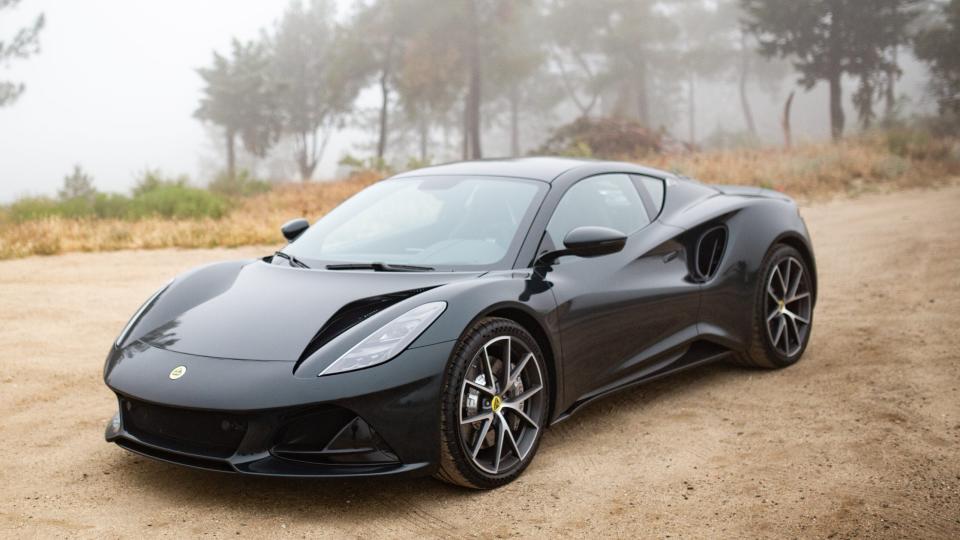
It’s easy to forget how sketchy driving is. Especially the sort of driving you'd want to do in the 2023 Lotus Emira. Modern sports cars are so good, so talented, and so unbelievably well-developed that even the best of them still have a degree of separation from the raw machinations of the tires, road, and steering.
There is no such separation in the Emira. There’s no bullshit electric power steering, road feedback filtering, or road-crown compensation. Just a hydraulically-assisted rack. There’s no dual-clutch automatic solving shifts for you but a six-speed manual gearbox that doesn’t even rev-match. There’s hardly any stability or traction control—until the very last “Oh shit,” you’re on your own.
I almost couldn’t believe a car like the Emira could exist. A car that doesn’t trade raw information for the perception of handling and agility. It just shouts about everything. It holds nothing back. It isn’t kind, nor is it gentle. It’s what sports cars used to be. And it isn’t here to train rookies.


2023 Lotus Emira Specs
Price as tested: $94,960
Powertrain: 3.5-liter supercharged V6 | 6-speed manual | rear-wheel drive
Horsepower: 400
Torque: 417 lb-ft
Seating capacity: 2
Curb weight: 3,175 pounds
Cargo volume: 12.6 cubic feet
0-60 mph: 4.3 seconds
Top speed: 180 mph
Quick take: Shockingly raw and communicative but has an edge that can catch you out.
Score: 8.5/10
Lotus Evora (Emira's Version)
There’s a good reason it feels old school—almost none of the mechanicals come from the new school of automotive engineering. Underneath the bodywork of the Lotus Emira is essentially a shortened Evora. It uses the same dual-wishbone suspension front and rear, a similarly Porsche 911-esque rear-biased weight distribution of 39/61, the same Toyota-based 3.5-liter supercharged V6, and most crucially, the same hydraulic power steering system.
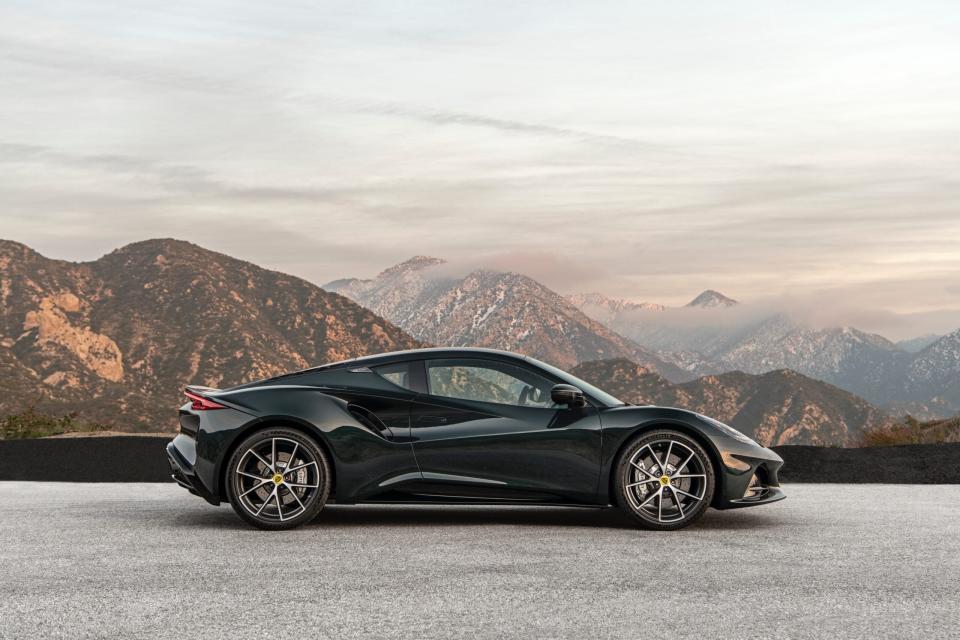
What the Emira updates are where the Evora fell short: interior quality and styling. Where there had to be strong excuses made for the off-the-shelf Alpine head unit and ‘90s-looking gauge cluster in the Evora (not to mention the compromised pedal box), the Emira looks and feels new but drives in the best ways of old.




All of it is functional. Those huge boomerang-shaped cuts in the hood extract hot air from a large front-mounted radiator and two auxiliary heat exchangers flanking it. Behind the rear wheels are exposed channels that help extract high-pressure air from the wheel wells. Next to the driver’s left ear is a side-mounted engine air intake, while the passenger side intake provides cool air to the engine bay.
Style
Aesthetically, it’s a real neckbreaker in person. It looks small, undeniably exotic, and has a presence to rival cars four times its price. The Emira made me feel like James Dean. More specifically, the James Dean who appears in that one Taylor Swift song. Our Reviews Editor Chris Tsui is turning me into a Swiftie. [Ed. note: Look what I made you do. -CT]
The inside is a colossal upgrade from the Evora, with the pedal box and front sill of the aluminum tub being repackaged to offer a little more foot space and easier ingress. Fundamentally, it’s the same bonded material made up of extrusions and folded sheets of aluminum as the Evora’s tub, which is a uniquely Lotus invention.




A 10.25-inch infotainment screen brings the Emira to the current decade while a 12.3-inch LCD gauge cluster has good black levels and a high refresh rate. Decked out in an enthusiastic amount of Alcantara, it’s a convincingly cool-looking, high-quality cabin that values maximal design over considered elegance while nailing the driving essentials. The seating position is floorboard-low, the adjustable steering column brings the wheel right to my chest, and the tall shift lever is never more than a relaxed hand’s width away.
Yet, this maximum-cool design presents odd challenges. To start the Emira, you have to flip up a red protective cover, à la Lamborghini. All it really ends up doing is force you to use your pinky to start the car from in between the gaps of the red cover.
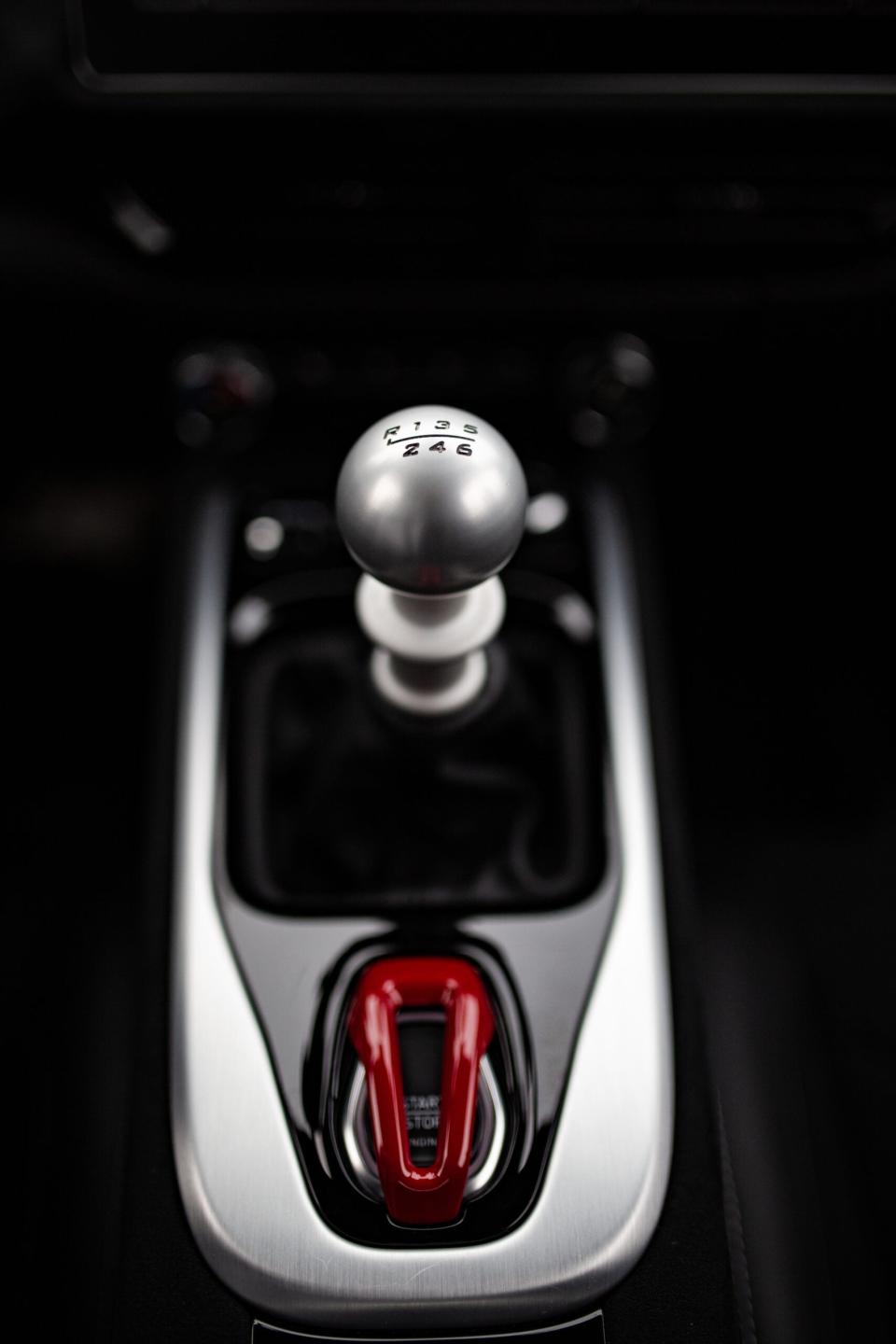
What's more, the thigh supports on the seat extended too far and didn’t fall off aggressively enough, so the seat would tickle my calves. The steering wheel is of an idiotic squircle shape and is hugely thick at nine and three. Finally, the drive selector for Tour, Sport, and Track modes is complete nonsense. It doesn’t respond to the first input, requiring two toggles. It’s also just slow.




The upshot here, though, is that the drive modes don’t really do anything. There are no adaptive dampers, no adaptive power steering, no rear-steer, and no fake engine noise. All they do is change throttle response slightly and turn stability control from “kinda on” in Tour to “taking a nap” in Track. That’s the core of the Emira: simplicity. What I didn’t expect was the outer edges of the car to be serrated so aggressively.
I Knew You Were Trouble
It was unbelievable on a slow, twisting canyon road. Relatively stiff high-speed damping (read: small, sharp bumps that happen at high damper speeds), a healthy amount of roll stiffness, and a featherlight nose all contribute to some of the most commanding turn-in of any sports car in the last decade. All without rear-wheel steering, active roll bars, or adaptive dampers. The true joy of the Emira lies in how single-mindedly focused it is on being an authentic sports car.
That’s where the fear comes from, too. Tuners know that everything has a compromise. Adding stiffness to suspension increases its natural frequency—putting it simply, everything happens quicker. That’s the bounciness you feel in a stiff car. It’s simply attenuating the road at a more rapid pace. This effectively reduces the car’s reaction time to handling events like bumps, turn-in, and slides giving you, the driver, less time to react. This was never more true than in the Emira.


It’s not that the Emira was globally stiff, even with the sport suspension that my tester came with. It rode reasonably well over broken pavement and used the full stroke of its suspension travel gracefully. The Emira is always adjustable at all stages of the corner, yet after that electrifying initial response, it never quite settled into place. It never became sure of itself, and always required a little nibble at the steering to know where it really was. It demanded nothing less than micrometric precision and athletic aggression and would lash out at the mere suggestion of amateurism. The Lotus would chastise you for offering throttle too early, or not rolling off of the brake exactly how it wants you to, while also refusing to tell you what you did wrong. “Figure it out,” the Emira says.
Steering the Emira is where things got fascinating. In some regards, the Emira’s steering is unmatched but falls short in other aspects. Information twisted and wriggled through the wheel, with an almost overwhelming amount of tugging happening on-center in response to every little change in camber and dip in the pavement. Those initial moments of sensation were thrilling, but that talkativeness didn’t translate into much weight. The Emira’s steering effort curve remained flat and over-assisted regardless of cornering load or speed and only came alive beyond what anyone would consider reasonable for the street. And the slow ratio meant that low-speed turns took crossed arms, while high-speed sweepers always required more input than I anticipated.



It took getting used to, and that’s not necessarily the Lotus I’ve been sold on. Driving the Emira as it was intended—which is through a canyon road—took an amount of surrendering to the adrenaline. It wasn’t a thoughtful driving experience. It was a shut your brain off, nerd experience that always left a shard of fear in my throat. Everything screams, especially the supercharged V6. The heavy, non-bushed sequential-esque action of the shift lever, the onslaught of sensation, responsiveness, and waves of fear were relentless. I might want to feel that way, but not everyone does. The Emira bit often, and bit in ways that I’ve never felt a sports car do in a long time. A lot of this character is likely down to the Lotus-spec 240-treadwear Michelin Pilot Sport Cup 2 tires, which I've tested on my own time and found to be uncommunicative in a similar way.
You Need to Calm Down
This is the tough part of the Emira. It presents itself as it sees the world and makes zero compromises for the less initiated. It has character and texture like rough fur and is highly imperfect. For every moment of post-corner clarity, the Emira changes very subtly and doesn’t react in the same way every time. That rear-biased weight distribution offers prodigious rear traction while the lightness of the front encourages deeper braking and later turn-in. Yet that aforementioned stiffness means breakaway at either axle is alarming and immediate. There is no softness to the edge. It is grip, grip, grip—nothing.
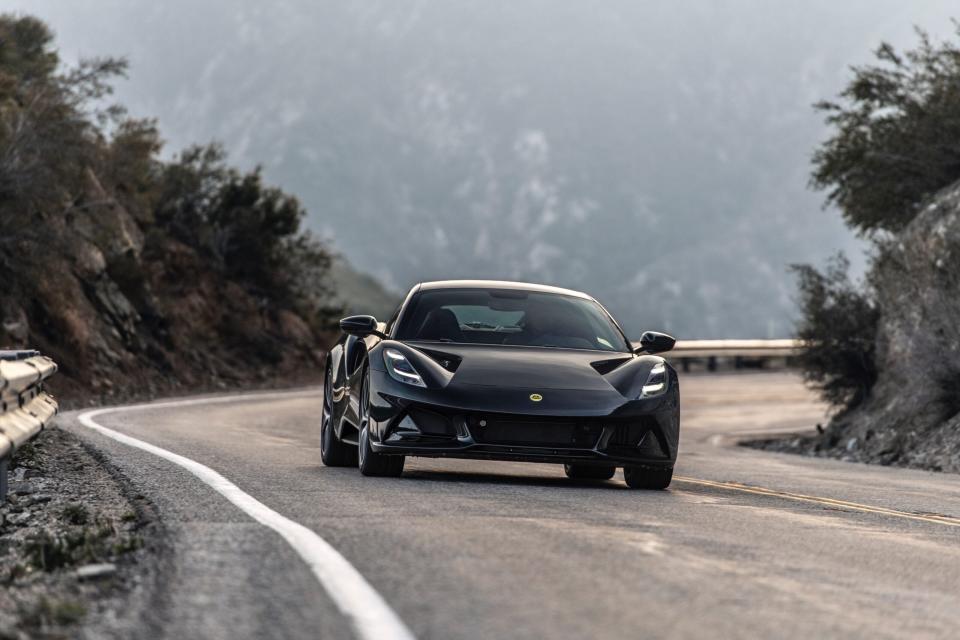
It is exhilarating. No, it doesn’t subscribe to the new school of unimpeachable handling. It will teach you a lesson the hard way. Despite its new, swanky interior and exotic exterior, driving the Emira isn’t for everyone. It’s ragged and responsive. It scares you straight. But sometimes, it's a little too much.
Getaway Car
For those wondering, it isn’t like a Porsche Cayman. The 2023 Lotus Emira is its own thing.
There is no other supercharged mid-engined V6 road car with a manual transmission, certainly not one with the same weight distribution as a modern 911. The new body and interior might trick you into thinking it wants to go mass market, but its true personality is more goth kid than jock. It is nicer to drive every day than an Evora GT, but it’s no luxury product. There’s road, gearbox, and raw mechanical engine noise humming quite proudly from the engine bay, and the windows start peeling away from the body around when that third digit on the speedo pops up.
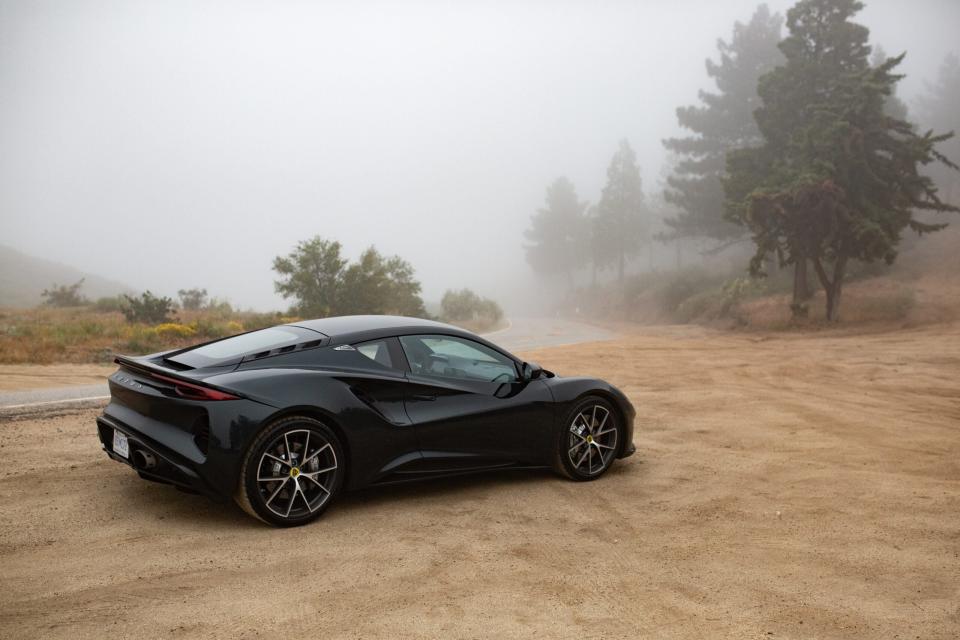
The Emira is, truthfully, unrefined. But it’s the first car in a long time that made me question if refinement matters at all. Everyone just wants to feel something, with our serotonin getting robbed from us by the internet. It’s escape in a metal cage. I felt real fear behind the wheel of the Emira, where the edge was always just in my peripheral but never quite visible until it came in shocking focus just before I could’ve fallen over.
I’d like a bit more of that, please.
Want to chat British sports cars in foggy weather? Hit my line at chris.rosales@thedrive.com

 Yahoo Autos
Yahoo Autos 